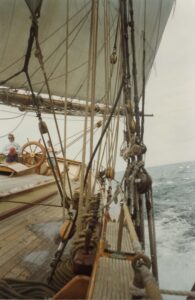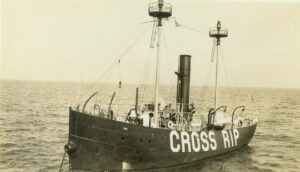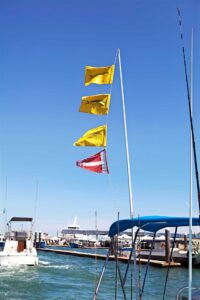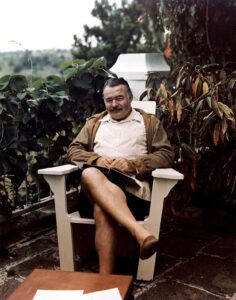There are few yacht owners who don’t respect the power of the sea, and there are even fewer who have not heard of the Edmund Fitzgerald. Of the thousands of shipwrecks on the Great Lakes, the “Fitz” is the most well-known and the most controversial. Next year marks the 40th anniversary of the sinking, and there is still no definitive answer to the cause.
The Ship
The SS Edmund Fitzgerald was christened in June 1958 and when launched was the largest ship on the Great Lakes. She was built as a bulk freighter carrying taconite iron ore pellets from the mines of Minnesota’s Iron Range north of Lake Superior to the steel mills of Michigan and Ohio. Powered by a steam turbine and a single propeller almost 20 feet in diameter, the Fitzgerald carried 30,000 tons of iron ore in the cargo hold of her 729-Foot hull.
Since Great Lakes freighters are built for freshwater, they have a life expectancy of over 50 years. By the end of 1975, after 17 years of service, the Fitzgerald had completed almost 750 round trips from Duluth to Detroit or Toledo. Many years of profitability were still expected by the ship’s owner, Northwestern Mutual Life Insurance, and its Chairman of the Board and ship’s namesake, Edmund Fitzgerald.
The Final Run Down the Lakes
On the afternoon of November 9, 1975 the Edmund Fitzgerald cast off her lines from the docks at Superior, Wisconsin (just across the bay from Duluth) with Capt. Ernest McSorley at the helm. She had a full load of taconite pellets to feed the blast furnaces of Zug Island just south of Detroit. McSorley, a veteran Great Lakes master, intended to retire at the end of the shipping season. That afternoon, the National Weather Service predicted a storm would pass over Lake Superior and the Fitzgerald’s route the following day.
Joining the Edmund Fitzgerald downbound Lake Superior toward the Soo Locks was another ore freighter, the SS Arthur M. Anderson. They sailed in tandem about 10 to 20 miles apart. At 7 p.m., the weather forecast was upgraded to gale warnings for all of Lake Superior. Five hours later, in the early morning of Nov. 10, the National Weather Service issued a storm warning predicting northeast winds 35 to 50 knots with waves 8 to 15 feet. Just before that storm warning was broadcast, the Fitzgerald noted winds out of the north-northeast at 52 knots, with seas of 10 feet.
As the weather and sea conditions deteriorated the two vessels left the regular shipping channels to seek the safety of the lee shore on the Canadian side of the lake to the east, a standard practice. The morning and
afternoon of November 10 wore on, and the storm center passed overhead, snow began to fall and the Anderson lost sight of the Fitzgerald some 16 miles ahead. At about 3:30 p.m., Capt. McSorley radioed “I have a fence rail down, have lost a couple of vents, and have a list.” The Fitzgerald also advised that two bilge pumps were running and she would slow down to allow the Anderson to catch up.
A half-hour later, as the sun was setting amid the snowstorm, McSorley radioed the Anderson again. Fitzgerald had lost both radars and was effectively blind as darkness approached. He asked that Anderson provide navigational assistance to help her steer toward the safety of Whitefish Bay. At 5:30 p.m., using radar, the Anderson fixed Fitzgerald at 35 miles northwest of Whitefish Point. At about the same time, McSorely spoke on VHF radio to the northbound Swedish freighter Avafors. He remarked that “am taking heavy seas over the deck in one of the worst seas I have ever been in.” During this period, Anderson experienced wind gusts from 70 to 75 knots with waves between 18 and 25 feet.
At 7:10 p.m. McSorley told Anderson that Fitzgerald was “holding her own.” Ten minutes later, the Edmund Fitzgerald had vanished from the Anderson’s radar screen. Concurrently, visibility from the Anderson had increased and lights on shore were clearly seen 20 miles away. The lights of the Fitzgerald, only 10 miles away, should have been visible but weren’t. The Edmund Fitzgerald sailed no more, and all 29 souls on board were lost at sea.
The Wreckage
Four days after she went down, a U.S. Navy search plane discovered the Fitzgerald about 17 miles from Whitefish Bay in 530 feet of water using magnetic detection equipment. The following spring, in May 1976, a U.S. Navy unmanned submersible was sent down to the lakebed to take a look. There lay the Edmund Fitzgerald, broken in two. The bow section, 276 feet long, rested upright in the mud. The stern section, 253 feet in length, sat upside down and askew of the bow section 170 feet away. The remaining 200 feet of midsection was a jumble of taconite and twisted steel.
What Caused the Sinking? Theories Abound
The Cargo Hold Flooding Theory: In July 1977, The U.S. Coast Guard concluded that the loss of the Fitzgerald was a result of ineffective hatch closures that caused gradual flooding of the cargo hold when green water was shipped on board. That report also implied that the crew did not fasten or maintain the hatch clamps properly. The following year, the National Transportation Safety Board ‘s report disagreed with the USCG’s findings and determined “the probable cause of the accident was the sudden massive flooding of the cargo hold due to the collapse of one or more hatch covers.”
The Waves and Weather Theory: The U.S. government funded a computer simulation in 2005 to re-create the wind and wave conditions on the day before, the day of and the day after the accident. The simulation produced significant wave height over 25 feet which would have caused the Fitzgerald to roll heavily in sustained winds over 60 knots, with gusts up to 75.
The Rogue Wave Theory: The captain of the Anderson reported that a series of two or three waves 30 to 35 feet in height struck his ship at 6:30 p.m. causing severe damage to a lifeboat and burying the deck in heavy seas. This train of rogue waves then continued on in the direction of Fitzgerald and would have struck her about the time she went down.
The Shoaling Theory:The Lake Carriers’ Association, which represents owners and operators of U.S. flagged ships on the Great Lakes, believes that the Fitzgerald grounded on an unknown reef near Six Fathom Shoal north of Caribou Island about four hours before she sank.
The Structural Failure Theory: A maritime historian thinks that the design and subsequent modifications to the Fitzgerald after she was built led to a weakened structure that was susceptible to fatal stress fractures caused by the continuous pounding of waves in heavy seas.
Epilogue
Beginning in 1980, a number of privately and publicly funded manned underwater surveys have taken place, but none of these dives have proved or disproved any of the theories of the sinking. And we will probably never know the reason. However, a series of salvage dives in 1995 recovered the ship’s bell, which has been restored and is on display at the Great Lakes Shipwreck Museum as a tangible memorial to the loss of the captain and crew aboard the Edmund Fitzgerald.
“Does any one know where the love of God goes when the waves turn the minutes to hours? The searchers all say they’d have made Whitefish Bay if they’d put 15 more miles behind’er. They might have split up or they
might have capsized; they may have broke deep and took water. And all that remains is the faces and the names of the wives and the sons and the daughters.” — Gordon Lightfoot, from “The Wreck of the Edmund Fitzgerald”
Capt. Jeff Werner has been in the yachting industry for over 25 years. In addition to working as a captain on private and charter yachts, both sail and power, he is a certified instructor for the USCG, US Sailing, RYA and the MCA. He is also the Diesel Doctor, helping to keep your yacht’s fuel in optimal condition for peak performance. For more information, call 239-246-6810, or visit MyDieselDoctor.com. All Marinalife members receive a 10% discount on purchases of equipment, products and supplies from Diesel Doctor.





